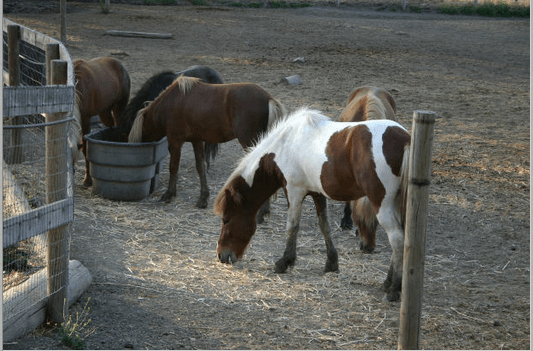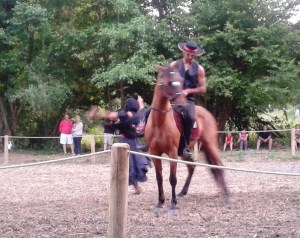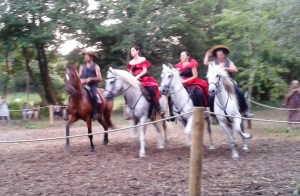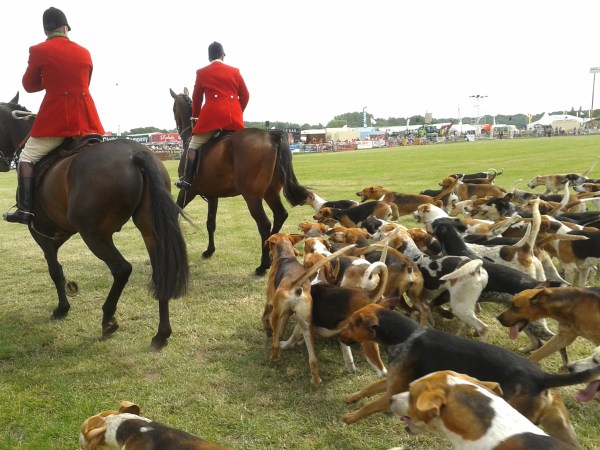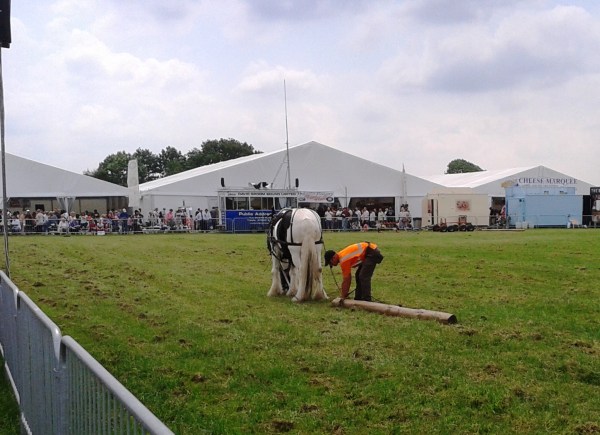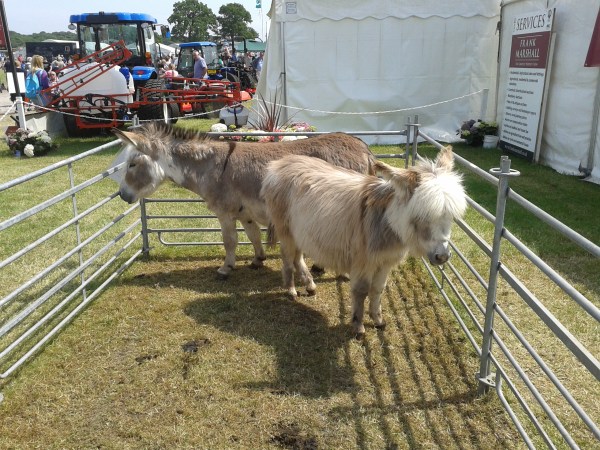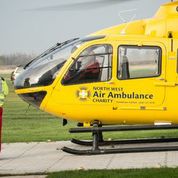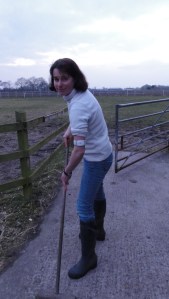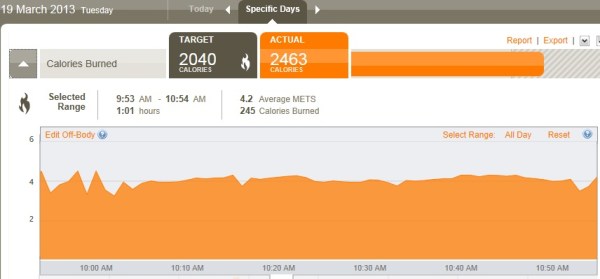Understanding your horse’s behaviour
Trainee animal behaviorist Beth Gibbons is currently studying at the Natural Animal Centre in Wales, and talked to the members of New Barn about meeting the natural needs of your horse.
Beth is studying a range of topics including the science of behaviour , neurology, psychology, the way that horses learn, ethology (the scientific and object study of animal behaviour), endocrinology (the diagnosis and treatment of diseases related to hormones), welfare and abnormal behaviours.
“It’s an eclectic mix, but it means that we’re able to understand the biological mechanisms and driving forces of a behaviour,” she explains.
“Left to themselves, horses behave in a certain way. They’re herbivores/prey animals, live in a hierarchy within a herd, and highly sociable, are trickle feeders/grazers, travel over defined territories and sleep for around to hours in 24. These are normal behaviour patterns.
“There’s an important social aspect to their behaviour, which manifests itself in the herd hierarchy and body care such as mutual grooming. They’ve evolved these behaviour patterns over thousands of years, and they’re a vital survival tool.
“In the wild, a horse will graze for around 16 – 20 hours a day, eating low quality forage and moving over a large area. They sleep in two-hour bouts, although they have around five different types of sleep from dozing to REM. Around 9% of their time is spent in REM sleep, and the herd will never all sleep together. Interestingly, a horse must be lying completely flat to get any REM sleep, which is vital to health and well-being.”
 “Horses have had a very long evolution – the proto-horse, eohippus, lived over 60 million years ago. It’s only relatively recently, in the last 8,000 years or so, that horses have been domesticated, and even then it was originally as meat animals rather than transport. Horses’ behaviour has evolved slowly in response to their environment, and in the short time we have domesticated them these behaviours have changed very little as there’s been insufficient time for them to naturally evolve and adapt. However, the circumstances of our relationship with horses have changed dramatically.Bearing that in mind, it’s easy to see that the way we keep our modern horses can be stressful for them.”
“Horses have had a very long evolution – the proto-horse, eohippus, lived over 60 million years ago. It’s only relatively recently, in the last 8,000 years or so, that horses have been domesticated, and even then it was originally as meat animals rather than transport. Horses’ behaviour has evolved slowly in response to their environment, and in the short time we have domesticated them these behaviours have changed very little as there’s been insufficient time for them to naturally evolve and adapt. However, the circumstances of our relationship with horses have changed dramatically.Bearing that in mind, it’s easy to see that the way we keep our modern horses can be stressful for them.”
- “The typical modern horse is stabled overnight for maybe 16 hours. He’s fed one or two haynets and hard feed, with other set hours for exercise or grooming. If you consider Brambells’s five freedoms, introduced in the 1960s to form the foundation of the basic welfare standard for animal care, you can see that we’re sometimes denying the stabled horse the ability to express his natural behaviour.”
The five freedoms:
- Freedom from hunger and thirst
- Freedom from discomfort
- Freedom from pain, injury or disease
- Freedom to act out natural behaviour.
- Freedom from fear and distress
A day in the life of a wild horse
A day in the life of a stabled domestic horse
“In the case of the stabled horse above, we don’t really know what he spends his 16 hours of stable time doing, and some horses can develop abnormal behaviours as coping mechanisms,” says Beth.
“These are behaviours abnormal in frequency, duration or tendency, sometimes known as stable vices. These can be caused by anxiety or frustration, or be examples of ‘vacuum behaviour’, evolved to fill time. Some horses can also exhibit signs of aggression.
- “There’s also a range of behaviour known as ‘stereotypies’, which refers to an unchanging pattern of behaviour that doesn’t serve an apparent purpose, such as crib biting, weaving, box walking, wind sucking or self mutilation (harming themselves). These are all examples of maladaptive behaviour, which fill the gaps left by the inability to practice normal behaviour.
“As horse owners, it’s not always practical to keep our horses in a 100% natural environment, but it’s always interesting to ask the question, “If my horse had the choice, what would he choose to do?”
“You might be surprised at the answers.”
Win tickets to Blenheim International Horse Trials
 It’s one of the highlights of the equestrian calendar. Set in the stunning surroundings of Blenheim Palace, Oxfordshire, this year’s Blenheim International Horse Trials are taking place between the 12th and the 15th September 2013.
It’s one of the highlights of the equestrian calendar. Set in the stunning surroundings of Blenheim Palace, Oxfordshire, this year’s Blenheim International Horse Trials are taking place between the 12th and the 15th September 2013.
With the chance to visit the house and groups, browse dozens of trade stands and see the top event riders compete, the International Horse Trials really does offer something for everyone.
Now Fidelity, the sponsors of the event, have launched a thoroughly modern competition using Twitter to win a pair of tickets to this year’s horse trials, £200 to spend on Ariat equestrian equipment and a year’s subscription to Eventing magazine. Nine runners-up will each win a pair of tickets.
Find out more about the competition, including how to enter, here –
https://www.fidelity.co.uk/static/blenheim/
Follow on Twitter: @FidBlenheim
Laminitis is a painful and potentially crippling equine disease that can be fatal. It’s extremely important to understand what it is, its causes and how to prevent the disease.
What is Laminitis?Laminitis is is a disease associated with ischaemia of digital dermal tissues and not an inflammatory disease, which is a common misconception. The onset of laminitis can cause the inter-laminar bonds, the only means of support of the distal phalanx within the hoof, to be destroyed. If enough of these bonds are destroyed, the animal becomes foundered meaning the pedal bone moves distally within the hoof.
What are its causes?
There are no specific causes of laminitis however the following situations are thought to contribute. These include; toxaemia – any systemic disease involving a septic or toxic focus, trauma – fast or prolonged work on hard surfaces and hormonal imbalances caused by incorrect use of thyroxine supplements.
Obesity caused by overeating is the most common cause of laminitis. Owners with little or no understanding of horse management often overfeed their horses. There are also external pressures from feed companies and peers. Native ponies actually require very little to eat. How to prevent it
Restricting the grass intake can help to prevent overeating and obesity. Grass contains high amounts of soluble carbohydrates, which, if ingested in large amounts can lead to laminitis, most commonly occurring in spring and autumn.
Strip grazing can be a useful management tool, allowing control of the horse’s access to grass at all times. This requires a small amount of investment high visibility electric fencing. Ideally position the electric fence to divide the paddock in half or smaller is necessary – make sure the horse has access to water and shelter at all times. Allowing for the end posts to stay in one position, move the fence a small amount each day in a zig-zag shape. Move the electric fence end posts weekly as you see fit.
This method will be of benefit not only to the horses nutrition and control of obesity, but also to the paddock itself.
Author Bio:
Olivia Henderson is the content specialist for Fi-Shock – a world leader in electric fence systems. Fi-Shock systems provide safe, superior quality energisers, accessories, conductors (tape wire and rope), insulators, and electric fence components. Electric fences are an economical alternative to conventional or barbed wire fences.
**This is a guest post in association with Fi-Shock**
 Since we started living partly in France, we’ve noticed that the French do love their outdoor events. Blessed with a more consistent climate than the UK, during the summer there’s a constant stream of music festivals, car shows, evening markets and even a local beer festival, as well as date specific celebrations such as the 14th July. There’s also a fair sprinkling of horse shows – but don’t expect British-style gymkhanas. These shows are spectator only, and feature ‘le voltige’ (acrobatics such as dismounting and mounting at a gallop), carriage driving displays and processions.
Since we started living partly in France, we’ve noticed that the French do love their outdoor events. Blessed with a more consistent climate than the UK, during the summer there’s a constant stream of music festivals, car shows, evening markets and even a local beer festival, as well as date specific celebrations such as the 14th July. There’s also a fair sprinkling of horse shows – but don’t expect British-style gymkhanas. These shows are spectator only, and feature ‘le voltige’ (acrobatics such as dismounting and mounting at a gallop), carriage driving displays and processions.
We recently attended an evening event at the beautiful Abbaye de Bonnefont, a building that can trace its origins back to the 12th century. The garden courtyard plays host to a number of events, including an evening of live music with a light show projected onto the abbey wall.
We were there, though, for Follement Cheval, a two day event in celebration of the horse. This year’s event was Spanish themed, and boasted tapas and As it was so hot, we’d opted to attend only the final evening.
After the traditional late start, which we’re now becoming used to, the event finally kicked off at 8.30pm with a display by René Grassi of the Mas de l’âne gris, presenting his donkeys in a ‘spectacle asin’. Although designed to be a series of stunts and tricks performed by the four donkeys, bored with the long wait they obviously decided to take matters into their own hooves and stage a strike. Poor René became increasingly desperate as his donkey refused to unroll a carpet, put its head through a hoop or knock over a row of coloured cones, choosing instead to roll its eyes superciliously and crop grass.
René Grassi of the Mas de l’âne gris, presenting his donkeys in a ‘spectacle asin’. Although designed to be a series of stunts and tricks performed by the four donkeys, bored with the long wait they obviously decided to take matters into their own hooves and stage a strike. Poor René became increasingly desperate as his donkey refused to unroll a carpet, put its head through a hoop or knock over a row of coloured cones, choosing instead to roll its eyes superciliously and crop grass.
Eventually, the pleading René managed to persuade his errant charges to stand on a block, and grudgingly count to 10. Which just does to show, you really can’t make a donkey do something it doesn’t want to do.
Afterwards, as the soft twilight came rolling down the valley, the audience of forty or so stood up and walked the few hundred yards to the arena, where the main attraction would perform.
 Up tempo Spanish music burst from the loudspeakers, and two riders on stunning Andalusian horses galloped into the ring, coming to dramatic sliding stops. The two then performed a series of stunts, which the commentator incongruously assured us were ‘cossack style’, flinging themselves nonchalantly between their horses and the ground.
Up tempo Spanish music burst from the loudspeakers, and two riders on stunning Andalusian horses galloped into the ring, coming to dramatic sliding stops. The two then performed a series of stunts, which the commentator incongruously assured us were ‘cossack style’, flinging themselves nonchalantly between their horses and the ground.
Next was a display of Spanish dancing – a single dancer twirled and pirouetted around a stunning bay Andalusian, appropriately asked by his rider to perform a Spanish walk.
After more displays of groundwork and ridden dressage, all four riders plunged into the ring together – the two men and two girls all in traditional costume for a formal display of drill riding.
Finally, with the night closing around us and the midges starting to bite, we packed up to leave, and I couldn’t help thinking that the setting and intimacy of the event made it feel slightly surreal. The cheerful chaos that had surrounded the performance – spare donkeys grazing happily amongst the crowd, small children helping with the barbecue – added to, rather than detracted from the atmosphere.
If you’re ever in France in the summer and see a small, modest, printed note advertising one of these events, go – but be prepared to ‘vive la différence’.
Cheshire Show, Wednesday 20th June 2013
There was a huge turnout this year, and crowds taking advantage of the fine weather and varied programme of events, including a visit by Princess Anne.
Get into shape for spring with ‘horse-ercise’
Hot on the heels of new exercise classes such as zumba and hula-hooping, I’m going to start my own fitness craze – horse-ercise. I’ve always known that horse riding is good for you, and offers a range of mental and physical health benefits ranging from low impact exercise to de-stressing. Until now, however, I’ve never really appreciated just how good for you looking after horses on a day-to-day basis can be.
Last week, for a magazine article, I was asked to wear an activity monitor for seven days. The point was to monitor my weekly exercise routine with my dog, Monty, to see how many calories I could expect to burn during a typical week’s dog walking. As I was wearing the monitor 24/7, I also ended up monitoring, by default, all my riding and stable chores, and the results were surprising. Here’s how I got on.
To give you an idea, during half an hour’s brisk walking with Monty I burnt 140 calories on average; a half-hour run burned around 200.
Riding and groundwork
1 hour’s hack, walking only – 250 calories
1 hour’s hack, walking and brisk trotting – 300 calories
1/2 hour light schooling (walk, trot, lateral work, no cantering) – 140 calories
1/2 hour lunging – 100 calories
1/2 hour long-reining – 140 calories
Stable jobs
14 minutes poo picking in field – 43 calories
25 minutes general stable jobs – skipping out, cleaning and re-filling buckets, filling haynets – 100 calories
1 hour 20 general stable jobs – turning out, skipping out, sweeping up etc – 334 calories. On Sundays, we have a yard rota and this Sunday was my turn. I turned out eight horses, then skipped out, watered and filled nets for four.
5 minutes grooming – 15 calories
The monitor
The activity monitor was kindly on loan from Ki Performance. As well as monitoring calorie burn, it also measured the number of steps taken, sleep quality, and exercise quantity and intensity. It was around the size of a large wristwatch, fitted comfortably and securely and I soon forgot it was there. Every so often, I downloaded my data to a computer, and retrieved my results which were automatically calculated and presented for me.
The results
While some of the results were expected – poo picking, for example, consisting of a brisk walk with a loaded wheelbarrow, came out as a little more intensive than plain walking – some were very surprising. I couldn’t believe that an hour’s hack at walk would burn 250 calories, which is only a little less than if I’d walked an hour on my own feet. The experts at Ki Performance, though, confirmed that my results were trustworthy. Although the monitor’s step counter may have been confused by the fact that I was on a horse, the calorie count would still have been accurate, as it was measuring my readings such as skin temperature and pulse rate to calculate a result. As I’m reasonably riding fit, I never feel that an hour’s hack is particularly energetic – but it’s obviously harder exercise that I thought. Also, the stable chores are exercise I have to do every day, rain or shine – whereas I know I’d never keep up a regular visit to the gym.
So, buy into the benefits of horse-ercise – even if you have a retired horse that’s no longer rideable, leading him out for half an hour, trying a horse agility session or just giving him a thorough grooming every day will benefit you both, and could be better exercise than you think.
The Ki Fit armband automatically captures your individual metabolic profile by collecting 5000 data points per minute, including calorie burn, amount and intensity of physical activity, and number of steps taken. Prices start at £99.99 plus a monthly subscription fee; available from Ki Performance.
